
Europe and Mediterranean: Ancient Mediterranean Voyage
Regent Seven Seas Cruises
Even hyperbole takes a holiday in the Mediterranean. Gorge on over 2,500 years of history in Cartagena, bask in all-things-Gaudi in Barcelona, overdo it on Italian culture and food, get your Greek Isles on, but mostly, prepare to be changed.

All onboard gratuities
Select complimentary shore excursions**
Unlimited beverages, including fine wines and premium spirits served throughout the ship
In-suite refrigerator replenished daily with soft drinks, beer and bottled water
24-Hour room service
No charge for specialty restaurants
Welcome bottle of Champagne
$100 Shipboard credit per suite††
Executive Member Benefit
Executive Members receive an annual 2% Reward, up to $1,250, on qualified Costco Travel purchases
Executive Members receive an additional $100 shipboard credit (per suite, not combinable with certain past-guest discounts)††
Digital Costco Shop Card
Member Exclusive: Digital Costco Shop Card with every Regent Seven Seas Cruises® sailing†
Onboard the Seven Seas Mariner
Seven Seas Mariner
Year Built: 2001
Year Refurbished: 2018
Double Occupancy Capacity: 700
The world’s first all-suite, all-balcony ship, Seven Seas Mariner® features four gourmet restaurants with open seating. Hallmarks include generous amenities and a welcome spaciousness throughout the ship. Catering to only 700 pampered guests, her staff-to-guest ratio of 1 to 1.6 ensures the absolutely highest level of personal service.
Activities & Services (included in cruise)
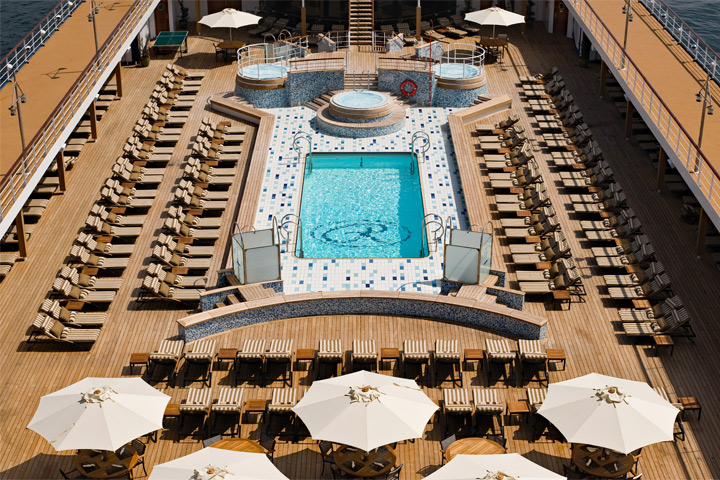
Pool
- Card Room
- Casino
- Disco/Nightclub
- Movies
- Fitness Center
- Sauna/Steam Room
- Educational Programs
- Pool - Outdoor
- Sports Facilities
- Whirlpool/Jacuzzi
- Bars/Lounges
- Library
- Wi-Fi
- Organized Age Specific Activities
- Teen Programs
- Business Center
- Concierge Desk
- Dry Cleaning/ Laundry Service
- Duty-Free Shops/Boutiques
- Elevators
Activities & Services (available for an extra fee)

Full-Service Spa
- Beauty Salon
- Full-Service Spa
- Babysitting
- Infirmary/Medical Center
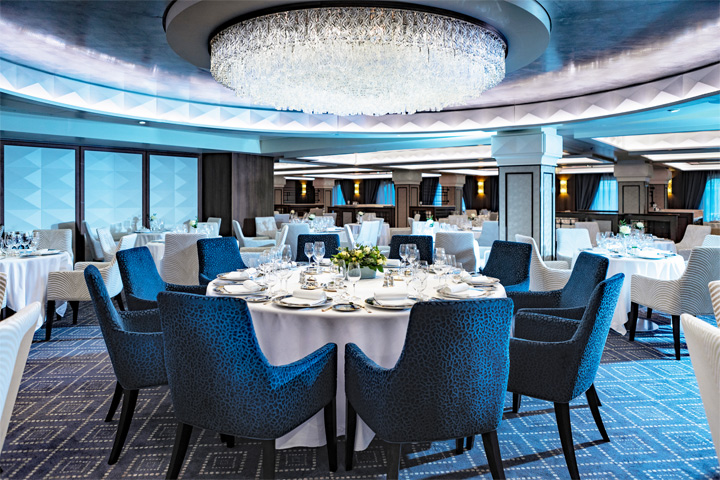
Compass Rose
Specialty Dining
Chartreuse: Featuring a classic French menu with a modern twist, Chartreuse evokes memories of a chic Parisian fine dining restaurant discovered during an evening stroll. Wherever you are seated in this regal restaurant, you will be treated to a succulent dinner while enjoying incredible ocean views. The restaurant ambiance is complemented by a menu that features dishes expertly prepared using both classic and modern techniques for a multiple course celebration of French gastronomy.
Compass Rose: Much thought was given to the design of Compass Rose, the flagship restaurant of Regent Seven Seas fleet. The dining room is outfitted with rich woods contrasted by light marble stones and mother of pearl shimmering brightly with an elegant color theme of light shades of blue, white, gold and silver. Compass Rose delights with a beautifully defined atmosphere and transitions from refreshing natural light during the day to a romantic ice blue lighting theme at night. This is the perfect setting for you to enjoy your breakfast, lunch and dinner, where the menu features an exceptional variety of Continental cuisine.
Prime 7: A true classic in every sense, Prime 7 sets a new standard in steakhouse fare with its contemporary interpretation of an American favorite. Handsomely decorated with supple leather wing-back chairs, burnished woods and rich earth-toned fabrics, Prime 7 exudes a distinct, intimate elegance. All the traditional starters are here, including Jumbo Lump Crab Cakes, Classic Steak Tartare, and Clam Chowder. Of course, beef is the undisputed star, and it is all USDA Prime and Dry-Aged at least 28 days to ensure the ultimate tenderness, juiciness and flavor. Prime New York Strip, Porterhouse Steak and succulent Filet Mignon only touch upon the selections. Mouthwatering alternatives include Alaskan King Crab Legs and Dover Sole. Prime 7 is open for dinner only and reservations are required.
Sette Mari at La Veranda: Each evening, La Veranda transforms into Sette Mari at La Veranda, a casual, intimate dining experience. Enjoy an extensive menu of authentic antipasti and Italian specialties served á la carte and paired with fine Italian wines — complimentary of course. Delectable dishes are prepared á la minute by talented chefs using only the freshest gourmet ingredients and served by attentive waiters. Sette Mari at La Veranda is open for dinner only.
Casual Dining
Coffee Connection: Your informal destination to relax, meet fellow guests and enjoy coffee and snacks throughout the day. While snacking, international newspapers and news magazines are available for your perusal.
La Veranda: Serving breakfast and lunch, La Veranda is exceedingly popular any time of the day. Spacious and comfortably casual, La Veranda offers regional specialties that often reflect the cuisines of the countries called on. Dishes are presented in a buffet style that displays the diversity of the menu. La Veranda also features an authentic pizzeria and a shaded, open-air veranda for dining al fresco.
Pool Grill: The Pool Grill is open-air, yet abundantly shaded for comfortable dining. Enjoy grilled-to-order burgers, grilled seafood, sandwiches, and fresh salads. Treat yourself to milkshakes and malts or an old-fashioned hand-dipped ice cream dessert sprinkled with all your favorite toppings.
Room Service: Complimentary 24-hour dining in the comfort of your stateroom.
Features a European king-size bed, a sitting area, a marble bathroom, a walk-in closet and a balcony. Concierge Level is available.
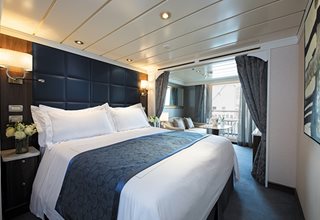
Category: H
Every inch of this suite has been thoughtfully designed to maximize interior space and embrace the magnificent scenery outdoors. From the sitting area, admire the ocean views through the floor-to-ceiling windows, or better yet, take a seat outside on your private balcony to watch the world go by. Elegant finishes such as luxurious bedding and beautiful marble detailing in the bath further enhance your comfort.
Suite size: 23.4 m²
Balcony size: 4.6 m²
Amenities:- Unlimited Wi-Fi Includes Two Logins, Two Devices, per Suite
- Valet Laundry Service
- Customizable In-Suite Mini Bar Replenished Daily with Your Preferences
- Welcome Bottle of Champagne and Fresh Fruit
- 24-hour In-Suite Dining
- Fresh Orchid Arrangement
- L'Occitane® Jasmin & Bergamot Bath Amenities
- Regent Plush Bathrobe and Slippers
- Interactive Flat-Screen Television and Direct-Dial Satellite Phone
- Vanity and Hair Dryer
- Shoe Shine Service

Category: G
Every inch of this suite has been thoughtfully designed to maximize interior space and embrace the magnificent scenery outdoors. From the sitting area, admire the ocean views through the floor-to-ceiling windows, or better yet, take a seat outside on your private balcony to watch the world go by. Elegant finishes such as luxurious bedding and beautiful marble detailing in the bath further enhance your comfort.
Suite size: 23.4 m²
Balcony size: 4.6 m²
Amenities:- Unlimited Wi-Fi Includes Two Logins, Two Devices, per Suite
- Valet Laundry Service
- Customizable In-Suite Mini Bar Replenished Daily with Your Preferences
- Welcome Bottle of Champagne and Fresh Fruit
- 24-hour In-Suite Dining
- Fresh Orchid Arrangement
- L'Occitane® Jasmin & Bergamot Bath Amenities
- Regent Plush Bathrobe and Slippers
- Interactive Flat-Screen Television and Direct-Dial Satellite Phone
- Vanity and Hair Dryer
- Shoe Shine Service

Category: F
Every inch of this suite has been thoughtfully designed to maximize interior space and embrace the magnificent scenery outdoors. From the sitting area, admire the ocean views through the floor-to-ceiling windows, or better yet, take a seat outside on your private balcony to watch the world go by. Elegant finishes such as luxurious bedding and beautiful marble detailing in the bath further enhance your comfort.
Suite size: 23.4 m²
Balcony size: 4.6 m²
Amenities:- Unlimited Wi-Fi Includes Two Logins, Two Devices, per Suite
- Valet Laundry Service
- Customizable In-Suite Mini Bar Replenished Daily with Your Preferences
- Welcome Bottle of Champagne and Fresh Fruit
- 24-hour In-Suite Dining
- Fresh Orchid Arrangement
- L'Occitane® Jasmin & Bergamot Bath Amenities
- Regent Plush Bathrobe and Slippers
- Interactive Flat-Screen Television and Direct-Dial Satellite Phone
- Vanity and Hair Dryer
- Shoe Shine Service
Spacious suites feature an in-suite iPad, daily canapés and upgraded bathroom amenities.
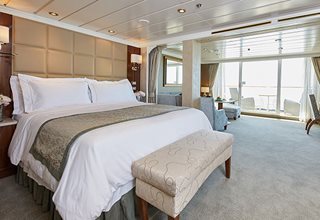
Category: A
The luxurious suite has been carefully designed to maximize space and comfort. Relax on your private balcony and indulge in your lavish bath amenities as you recharge and ready yourself for new adventures in the next port of call. This suite also includes priority online reservations for shore excursions and dining, and you're encouraged to call on the services of a personal butler for special requests.
Suite size: 34.9 m²
Balcony size: 6.8 m²
Amenities:- 1-Night Pre-Cruise Hotel Package Including:
- Ground Transfers
- Breakfast
- Porterage
- Unlimited Wi-Fi Includes up to Four Logins, Four Devices, per Suite
- Valet Laundry Service
- Customizable In-Suite Mini Bar Replenished Daily with Your Preferences
- Welcome Bottle of Champagne and Fresh Fruit
- 24-hour In-Suite Dining
- Fresh Orchid Arrangement
- L'Occitane® Jasmin & Bergamot Bath Amenities
- Regent Plush Bathrobe and Slippers
- Interactive Flat-Screen Television and Direct-Dial Satellite Phone
- Priority Access to Online Shore Excursion Reservations
- Priority Access to Online Dining Reservations
- Binoculars
- illy® Espresso Maker
- Cashmere Blankets
- Regent Special Gift
- Vanity and Hair Dryer
- Shoe Shine Service
- Additional Discounts:
- 10% Discount on Ultra Premium Wine and Liquor
- 5% Savings on Pre- or Post-Cruise Hotel or Land Programs
- 5% Savings on Regent Choice Shore Excursions
- Personal Butler for an Elevated In-Suite Experience
- In-Suite Dining from Compass Rose
- Daily Canapés
- Luxurious Designer Bath Amenities & Men's Unscented Shaving Kit
- Guerlain Bath Amenities & Men's Unscented Shaving Kit
- Bose® SoundLink Mini II Bluetooth Speaker
- Selection of Bed Pillow Styles
- Complimentary Garment Pressing on First Night
- Personalized Stationery upon request
- 1-Night Pre-Cruise Hotel Package Including:

Category: B
The luxurious suite has been carefully designed to maximize space and comfort. Relax on your private balcony and indulge in your lavish bath amenities as you recharge and ready yourself for new adventures in the next port of call. This suite also includes priority online reservations for shore excursions and dining, and you're encouraged to call on the services of a personal butler for special requests.
Suite size: 34.9 m²
Balcony size: 6.8 m²
Amenities:- 1-Night Pre-Cruise Hotel Package Including:
- Ground Transfers
- Breakfast
- Porterage
- Unlimited Wi-Fi Includes up to Four Logins, Four Devices, per Suite
- Valet Laundry Service
- Customizable In-Suite Mini Bar Replenished Daily with Your Preferences
- Welcome Bottle of Champagne and Fresh Fruit
- 24-hour In-Suite Dining
- Fresh Orchid Arrangement
- L'Occitane® Jasmin & Bergamot Bath Amenities
- Regent Plush Bathrobe and Slippers
- Interactive Flat-Screen Television and Direct-Dial Satellite Phone
- Priority Access to Online Shore Excursion Reservations
- Priority Access to Online Dining Reservations
- Binoculars
- illy® Espresso Maker
- Cashmere Blankets
- Regent Special Gift
- Vanity and Hair Dryer
- Shoe Shine Service
- Additional Discounts:
- 10% Discount on Ultra Premium Wine and Liquor
- 5% Savings on Pre- or Post-Cruise Hotel or Land Programs
- 5% Savings on Regent Choice Shore Excursions
- Personal Butler for an Elevated In-Suite Experience
- In-Suite Dining from Compass Rose
- Daily Canapés
- Luxurious Designer Bath Amenities & Men's Unscented Shaving Kit
- Guerlain Bath Amenities & Men's Unscented Shaving Kit
- Bose® SoundLink Mini II Bluetooth Speaker
- Selection of Bed Pillow Styles
- Complimentary Garment Pressing on First Night
- Personalized Stationery upon request
- 1-Night Pre-Cruise Hotel Package Including:

Category: C
The luxurious suite has been carefully designed to maximize space and comfort. Relax on your private balcony and indulge in your lavish bath amenities as you recharge and ready yourself for new adventures in the next port of call. This suite also includes priority online reservations for shore excursions and dining, and you're encouraged to call on the services of a personal butler for special requests.
Suite size: 34.9 m²
Balcony size: 6.8 m²
Amenities:- 1-Night Pre-Cruise Hotel Package Including:
- Ground Transfers
- Breakfast
- Porterage
- Unlimited Wi-Fi Includes up to Four Logins, Four Devices, per Suite
- Valet Laundry Service
- Customizable In-Suite Mini Bar Replenished Daily with Your Preferences
- Welcome Bottle of Champagne and Fresh Fruit
- 24-hour In-Suite Dining
- Fresh Orchid Arrangement
- L'Occitane® Jasmin & Bergamot Bath Amenities
- Regent Plush Bathrobe and Slippers
- Interactive Flat-Screen Television and Direct-Dial Satellite Phone
- Priority Access to Online Shore Excursion Reservations
- Priority Access to Online Dining Reservations
- Binoculars
- illy® Espresso Maker
- Cashmere Blankets
- Regent Special Gift
- Vanity and Hair Dryer
- Shoe Shine Service
- Additional Discounts:
- 10% Discount on Ultra Premium Wine and Liquor
- 5% Savings on Pre- or Post-Cruise Hotel or Land Programs
- 5% Savings on Regent Choice Shore Excursions
- Personal Butler for an Elevated In-Suite Experience
- In-Suite Dining from Compass Rose
- Daily Canapés
- Luxurious Designer Bath Amenities & Men's Unscented Shaving Kit
- Guerlain Bath Amenities & Men's Unscented Shaving Kit
- Bose® SoundLink Mini II Bluetooth Speaker
- Selection of Bed Pillow Styles
- Complimentary Garment Pressing on First Night
- Personalized Stationery upon request
- 1-Night Pre-Cruise Hotel Package Including:
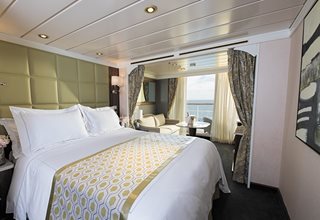
Category: D
In this superbly designed suite, you enjoy the comfort of richly furnished accommodations as well as exclusive luxuries available only in suites at the Concierge level and higher. Your suite includes amenities such as an illy® espresso maker and cashmere blankets, perfect for use in the morning when you wish to sip coffee and enjoy an in-suite breakfast on your private balcony. Take advantage of 24-hour room service when the mood strikes.
Suite size: 23.4 m²
Balcony size: 4.6 m²
Amenities:- 1-Night Pre-Cruise Hotel Package Including:
- Ground Transfers
- Breakfast
- Porterage
- Unlimited Wi-Fi Includes up to Four Logins, Four Devices, per Suite
- Valet Laundry Service
- Customizable In-Suite Mini Bar Replenished Daily with Your Preferences
- Welcome Bottle of Champagne and Fresh Fruit
- 24-hour In-Suite Dining
- Fresh Orchid Arrangement
- L'Occitane® Jasmin & Bergamot Bath Amenities
- Regent Plush Bathrobe and Slippers
- Interactive Flat-Screen Television and Direct-Dial Satellite Phone
- Priority Access to Online Shore Excursion Reservations
- Priority Access to Online Dining Reservations
- Binoculars
- illy® Espresso Maker
- Cashmere Blankets
- Regent Special Gift
- Vanity and Hair Dryer
- Shoe Shine Service
- Additional Discounts:
- 10% Discount on Ultra Premium Wine and Liquor
- 5% Savings on Pre- or Post-Cruise Hotel or Land Programs
- 5% Savings on Regent Choice Shore Excursions
- 1-Night Pre-Cruise Hotel Package Including:

Category: E
In this superbly designed suite, you enjoy the comfort of richly furnished accommodations as well as exclusive luxuries available only in suites at the Concierge level and higher. Your suite includes amenities such as an illy® espresso maker and cashmere blankets, perfect for use in the morning when you wish to sip coffee and enjoy an in-suite breakfast on your private balcony. Take advantage of 24-hour room service when the mood strikes.
Suite size: 23.4 m²
Balcony size: 4.6 m²
Amenities:- 1-Night Pre-Cruise Hotel Package Including:
- Ground Transfers
- Breakfast
- Porterage
- Unlimited Wi-Fi Includes up to Four Logins, Four Devices, per Suite
- Valet Laundry Service
- Customizable In-Suite Mini Bar Replenished Daily with Your Preferences
- Welcome Bottle of Champagne and Fresh Fruit
- 24-hour In-Suite Dining
- Fresh Orchid Arrangement
- L'Occitane® Jasmin & Bergamot Bath Amenities
- Regent Plush Bathrobe and Slippers
- Interactive Flat-Screen Television and Direct-Dial Satellite Phone
- Priority Access to Online Shore Excursion Reservations
- Priority Access to Online Dining Reservations
- Binoculars
- illy® Espresso Maker
- Cashmere Blankets
- Regent Special Gift
- Vanity and Hair Dryer
- Shoe Shine Service
- Additional Discounts:
- 10% Discount on Ultra Premium Wine and Liquor
- 5% Savings on Pre- or Post-Cruise Hotel or Land Programs
- 5% Savings on Regent Choice Shore Excursions
- 1-Night Pre-Cruise Hotel Package Including:
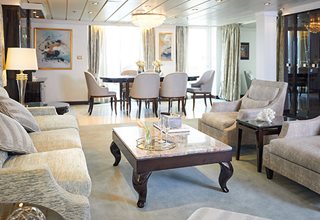
Category: SG
You'll find Park Avenue chic onboard Seven Seas Mariner® in this spectacular suite. Elegant rosewood furniture, luxe fabrics and a crystal chandelier create sophisticated comfort, while a personal butler is available to fulfill whatever requests you may have. With two bedrooms, two-and-a-half baths, a large living room and two private balconies, this sublime suite is perfect for hosting new friends in luxury.
Suite size: 111.9 m²
Balcony size: 74.1 m²
Amenities:- 1-Night Pre-Cruise Hotel Package Including:
- Ground Transfers
- Breakfast
- Porterage
- Unlimited Wi-Fi and Streaming Package for up to Four Devices
- Valet Laundry Service
- 24-hour In-Suite Dining
- Fresh Orchid Arrangement
- L'Occitane® Jasmin & Bergamot Bath Amenities
- Regent Plush Bathrobe and Slippers
- Interactive Flat-Screen Television and Direct-Dial Satellite Phone
- Priority Access to Online Shore Excursion Reservations
- Priority Access to Online Dining Reservations
- Binoculars
- illy® Espresso Maker
- Cashmere Blankets
- Regent Special Gift
- Vanity and Hair Dryer
- Shoe Shine Service
- Additional Discounts:
- 10% Discount on Ultra Premium Wine and Liquor
- 5% Savings on Pre- or Post-Cruise Hotel or Land Programs
- 5% Savings on Regent Choice Shore Excursions
- VIP Status Including Dinner with a Senior Officer
- Guaranteed Reservation Each Night in Specialty Restaurant of Your Choice
- Welcome Letter from the President and General Manager
- Personal Butler for an Elevated In-Suite Experience
- In-Suite Dining Menu Including Specialty Restaurant Selections During Dining Hours
- Priority Boarding on Embarkation Day with Suite Access at Noon
- Welcome Bottle of Premium Champagne
- Personalized In-Suite Full-Liquor Bar Set-Up
- A Sumptuous In-Suite Caviar Service Once During Cruises
- Complimentary In-Suite Cocktail Party for 8
- Complimentary 25-Minute Personal Fitness Session at the Serene Spa & Wellness™ Fitness Center
- Delivery of up to 3 Daily Newspapers and World Atlas
- Daily Canapés
- Tea Forté Set-Up
- Luxe Fruit Arrangement with Chocolate Leonidas
- Luxurious Designer Bath Amenities & Men's Unscented Shaving Kit
- Guerlain Box with Fragrance & Spongellé Buffer
- Hair dryer
- Selection of Fig and Tea Leaves Bath Salts
- Guerlain Bath Amenities & Men's Unscented Shaving Kit
- Bath Scale Setup
- Bose® SoundLink Mini II Bluetooth Speaker
- Selection of Bed Pillow Styles
- Complimentary Garment Pressing on First Night
- Personalized Stationery upon request
- Elegant Weather Clock
- Excursion Bag
- 1-Night Pre-Cruise Hotel Package Including:
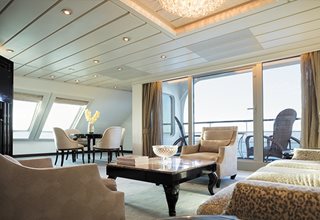
Category: GS
Step into the richness of a dining area perfectly ensconced within a spacious, art-filled living room. Just outside is a private balcony with a table and chairs just right for in-suite breakfast. The private bedroom is large and inviting, its soothing color palette conducive to a peaceful night's rest on your King-Sized Elite Slumber™ Bed. Two full baths and luxurious bath products invite you to indulge in unbridled 'me time'.
Suite size: 83.9 m²
Balcony size: 7.8 m²
Amenities:- 1-Night Pre-Cruise Hotel Package Including:
- Ground Transfers
- Breakfast
- Porterage
- Unlimited Wi-Fi Includes up to Four Logins, Four Devices, per Suite
- Valet Laundry Service
- 24-hour In-Suite Dining
- Fresh Orchid Arrangement
- L'Occitane® Jasmin & Bergamot Bath Amenities
- Regent Plush Bathrobe and Slippers
- Interactive Flat-Screen Television and Direct-Dial Satellite Phone
- Priority Access to Online Shore Excursion Reservations
- Priority Access to Online Dining Reservations
- Binoculars
- illy® Espresso Maker
- Cashmere Blankets
- Regent Special Gift
- Vanity and Hair Dryer
- Shoe Shine Service
- Additional Discounts:
- 10% Discount on Ultra Premium Wine and Liquor
- 5% Savings on Pre- or Post-Cruise Hotel or Land Programs
- 5% Savings on Regent Choice Shore Excursions
- VIP Status Including Dinner with a Senior Officer
- Guaranteed Reservation Each Night in Specialty Restaurant of Your Choice
- Welcome Letter from the President and General Manager
- Personal Butler for an Elevated In-Suite Experience
- In-Suite Dining Menu Including Specialty Restaurant Selections During Dining Hours
- Priority Boarding on Embarkation Day with Suite Access at Noon
- Welcome Bottle of Premium Champagne
- Personalized In-Suite Full-Liquor Bar Set-Up
- A Sumptuous In-Suite Caviar Service Once During Cruises
- Complimentary In-Suite Cocktail Party for 8
- Complimentary 25-Minute Personal Fitness Session at the Serene Spa & Wellness™ Fitness Center
- Delivery of up to 3 Daily Newspapers and World Atlas
- Daily Canapés
- Tea Forté Set-Up
- Luxe Fruit Arrangement with Chocolate Leonidas
- Luxurious Designer Bath Amenities & Men's Unscented Shaving Kit
- Guerlain Box with Fragrance & Spongellé Buffer
- Hair dryer
- Selection of Fig and Tea Leaves Bath Salts
- Guerlain Bath Amenities & Men's Unscented Shaving Kit
- Bath Scale Setup
- Bose® SoundLink Mini II Bluetooth Speaker
- Selection of Bed Pillow Styles
- Complimentary Garment Pressing on First Night
- Personalized Stationery upon request
- Elegant Weather Clock
- Excursion Bag
- 1-Night Pre-Cruise Hotel Package Including:
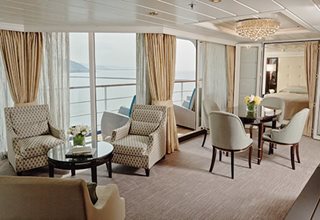
Category: MN
Spectacular panoramic views will seem to have been created just for you when you relax on your suite's private balcony. Comfortably located mid-ship, this suite has a spacious separate bedroom with a European king-sized Elite Slumber™ bed and one-and-a-half baths. This suite features a spacious walk-in closet with drawers as well. To elevate your experience even more, a personal butler will be on call to help make your onboard wishes come true.
Suite size: 60.4 m²
Balcony size: 8.3 m²
Amenities:- 1-Night Pre-Cruise Hotel Package Including:
- Ground Transfers
- Breakfast
- Porterage
- Unlimited Wi-Fi Includes up to Four Logins, Four Devices, per Suite
- Valet Laundry Service
- 24-hour In-Suite Dining
- Fresh Orchid Arrangement
- L'Occitane® Jasmin & Bergamot Bath Amenities
- Regent Plush Bathrobe and Slippers
- Interactive Flat-Screen Television and Direct-Dial Satellite Phone
- Priority Access to Online Shore Excursion Reservations
- Priority Access to Online Dining Reservations
- Binoculars
- illy® Espresso Maker
- Cashmere Blankets
- Regent Special Gift
- Vanity and Hair Dryer
- Shoe Shine Service
- Additional Discounts:
- 10% Discount on Ultra Premium Wine and Liquor
- 5% Savings on Pre- or Post-Cruise Hotel or Land Programs
- 5% Savings on Regent Choice Shore Excursions
- Welcome Letter from the President and General Manager
- Personal Butler for an Elevated In-Suite Experience
- In-Suite Dining from Compass Rose
- Priority Boarding on Embarkation Day with Suite Access at 1 pm
- Welcome Bottle of Premium Champagne
- Personalized In-Suite Full-Liquor Bar Set-Up
- A Sumptuous In-Suite Caviar Service Once During Cruises
- Delivery of up to 3 Daily Newspapers and World Atlas
- Daily Canapés
- Luxe Fruit Arrangement
- Luxurious Designer Bath Amenities & Men's Unscented Shaving Kit
- Selection of Fig and Tea Leaves Bath Salts
- Guerlain Bath Amenities & Men's Unscented Shaving Kit
- Bath Scale Setup
- Bose® SoundLink Mini II Bluetooth Speaker
- Selection of Bed Pillow Styles
- Complimentary Garment Pressing on First Night
- Personalized Stationery upon request
- Elegant Weather Clock
- 1-Night Pre-Cruise Hotel Package Including:
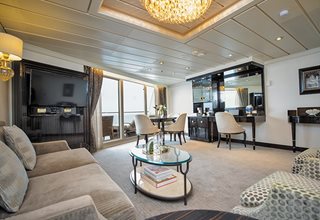
Category: SS
This suite welcomes you with soothing colors, pleasing artwork, and comfortable furnishings. Relax in the sitting area after an exciting day ashore and enjoy the selection of fresh canapés delivered by your personal butler. Then retreat to your private balcony to watch the ever-changing vistas and ponder your next destination. Up to one-and-a-half baths feature fine marble accents and a tub or walk-in shower.
Suite size: 47.0-52.1 m²
Balcony size: 9.0-26.6 m²
Amenities:- 1-Night Pre-Cruise Hotel Package Including:
- Ground Transfers
- Breakfast
- Porterage
- Unlimited Wi-Fi Includes up to Four Logins, Four Devices, per Suite
- Valet Laundry Service
- Customizable In-Suite Mini Bar Replenished Daily with Your Preferences
- 24-hour In-Suite Dining
- Fresh Orchid Arrangement
- L'Occitane® Jasmin & Bergamot Bath Amenities
- Regent Plush Bathrobe and Slippers
- Interactive Flat-Screen Television and Direct-Dial Satellite Phone
- Priority Access to Online Shore Excursion Reservations
- Priority Access to Online Dining Reservations
- Binoculars
- illy® Espresso Maker
- Cashmere Blankets
- Regent Special Gift
- Vanity and Hair Dryer
- Shoe Shine Service
- Additional Discounts:
- 10% Discount on Ultra Premium Wine and Liquor
- 5% Savings on Pre- or Post-Cruise Hotel or Land Programs
- 5% Savings on Regent Choice Shore Excursions
- Personal Butler for an Elevated In-Suite Experience
- In-Suite Dining from Compass Rose
- Priority Boarding on Embarkation Day with Suite Access at 1 pm
- Daily Canapés
- Luxe Fruit Arrangement
- Luxurious Designer Bath Amenities & Men's Unscented Shaving Kit
- Selection of Fig and Tea Leaves Bath Salts
- Guerlain Bath Amenities & Men's Unscented Shaving Kit
- Bose® SoundLink Mini II Bluetooth Speaker
- Selection of Bed Pillow Styles
- Complimentary Garment Pressing on First Night
- Personalized Stationery upon request
- Elegant Weather Clock
- 1-Night Pre-Cruise Hotel Package Including:
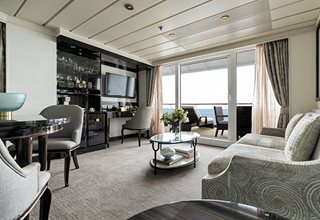
Category: HS
Located along the stern of Seven Seas Mariner®, this suite offers a panoramic vista and expansive balcony that is large enough for two cushioned chaises, two chairs and a table. Inside, the bed alcove is separated from a beautifully appointed sitting area by curtains, allowing you to control how much sunlight greets you each morning. You'll also have a personal butler attending to your needs and a bevy of luxurious amenities.
Suite size: 33.4 m²
Balcony size: 25 m²
Amenities:- 1-Night Pre-Cruise Hotel Package Including:
- Ground Transfers
- Breakfast
- Porterage
- Unlimited Wi-Fi Includes up to Four Logins, Four Devices, per Suite
- Valet Laundry Service
- Customizable In-Suite Mini Bar Replenished Daily with Your Preferences
- 24-hour In-Suite Dining
- Fresh Orchid Arrangement
- L'Occitane® Jasmin & Bergamot Bath Amenities
- Regent Plush Bathrobe and Slippers
- Interactive Flat-Screen Television and Direct-Dial Satellite Phone
- Priority Access to Online Shore Excursion Reservations
- Priority Access to Online Dining Reservations
- Binoculars
- illy® Espresso Maker
- Cashmere Blankets
- Regent Special Gift
- Vanity and Hair Dryer
- Shoe Shine Service
- Additional Discounts:
- 10% Discount on Ultra Premium Wine and Liquor
- 5% Savings on Pre- or Post-Cruise Hotel or Land Programs
- 5% Savings on Regent Choice Shore Excursions
- Personal Butler for an Elevated In-Suite Experience
- In-Suite Dining from Compass Rose
- Priority Boarding on Embarkation Day with Suite Access at 1 pm
- Daily Canapés
- Luxe Fruit Arrangement
- Luxurious Designer Bath Amenities & Men's Unscented Shaving Kit
- Guerlain Bath Amenities & Men's Unscented Shaving Kit
- Bose® SoundLink Mini II Bluetooth Speaker
- Selection of Bed Pillow Styles
- Complimentary Garment Pressing on First Night
- Personalized Stationery upon request
- Elegant Weather Clock
- 1-Night Pre-Cruise Hotel Package Including:

| Symbol | Description |
|---|---|
 | Three guest capacity suite; convertible sofa bed |
 | Wheelchair accessible suites have shower stall instead of bathtub |
 | Bathroom features a glass-enclosed shower instead of a bathtub |
 | 2-bedroom suite accommodates up to 6 guests |
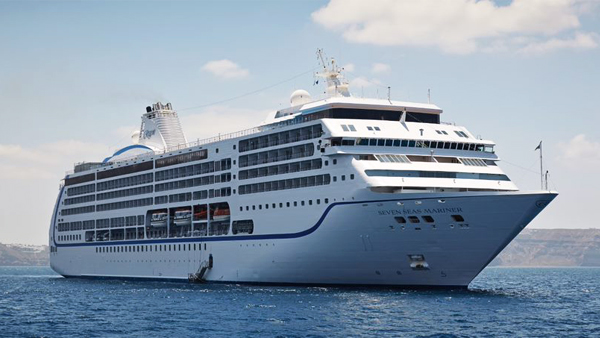
- Ship Name: Seven Seas Mariner
- Year Built: 2001
- Year Refurbished: 2018
- Year Entered Present Fleet: 2001
- Ship Class: Mariner
- Maximum Capacity: 700
- Number of Passenger Decks: 8
- Number of Crew: 445
- Officers' Nationality: International
- Tonnage (GRT): 48,075
- Capacity Based on Double Occupancy: 700
- Country of Registry: The Bahamas
- Total Staterooms: 350
- Suites with Balcony: 350
- Crew/Hotel Staff Nationality: European/International
Costco Member Reviews

Terms & Conditions
*Price shown is per person based on double occupancy, is valid for select stateroom categories only and does include government taxes/fees and gratuities. Click on the Terms & Conditions link below for details.
**Select complimentary shore excursions are for full-fare guests only, capacity controlled and subject to availability. Shore excursion reservations are accepted on a first-come, first-served basis. Please note, available excursions vary by sailing date and day of the week. Government fees and taxes are included. Requested excursions may not be available at time of booking. Supplement will apply on Regent Choice excursions and excludes Private Arrangements and all Adventures Ashore programs. Restrictions apply and penalties apply 36 hours prior to shore excursion start date.
††All shipboard credit is in U.S. dollars, is per stateroom based on double occupancy, has no cash value, is nontransferable and not redeemable for cash.
†One Digital Costco Shop Card per room/stateroom, per stay. The exact amount of the Digital Costco Shop Card will be calculated during the booking process. The Digital Costco Shop Card promotion is nontransferable and may not be combined with any other promotion. A Digital Costco Shop Card will arrive by email approximately 10 days after the start of your cruise. Click on the Terms & Conditions link below for additional information.
Ship's registry: The Bahamas
Digital Costco Shop Card
Book this vacation or cruise with Costco Travel and receive a Digital Costco Shop Card. The Digital Costco Shop Card is a convenient payment option in our warehouses and on Costco.com.







